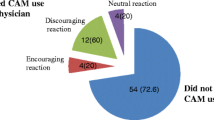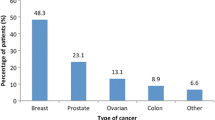Abstract
Objectives
We prospectively evaluated the prevalence and predictors of complementary medicine (CAM) use among Japanese patients with urologic cancer 1 year after diagnosis.
Patients and methods
A total of 349 patients with newly diagnosed urologic cancer answered a self-administered questionnaire on CAM use 1 year after diagnosis. General-health-related quality of life (GHQL) of the patients was also assessed at diagnosis and 1 year after diagnosis using the Medical Outcome Study Short Form-36 (SF-36). The overall prevalence, types of CAM used, and costs of CAM were assessed. The effects of several variables including GHQL at baseline and 1 year after treatment on the prevalence of use of CAM were evaluated.
Results
A total of 164 respondents (47%) admitted using some type of CAM, of which 73 (45%) had used multiple types. “Health food,” in particular extract from Agaricus blazei, was the most common type of CAM used. CAM users had significantly lower scores for social function, general health perception, and vitality domains than CAM non-users 1 year after diagnosis. This tendency was more marked in users of multiple types of CAM.
Conclusions
“Health food,” including extract from A. blazei, was the most commonly used CAM in Japan. The prevalence of CAM use did not differ between patients with prostate cancer and those with urologic cancer other than prostrate cancer. CAM users, especially those who used multiple types of CAM, had lower GHQL scores than non-users of CAM.


Similar content being viewed by others
References
Eisenberg DM, Kessler RC, Foster C et al (1993) Unconventional medicine in the United States: prevalence, costs, and patterns of use. N Engl J Med 328:246–252
Lippert MC, McClain R, Boyd JC et al (1999) Alternative medicine use in patients with localized prostate carcinoma treated with curative intent. Cancer 86:2642–2648
Kao GD, Devine P (2000) Use of complementary health practices by prostate carcinoma patients undergoing radiation therapy. Cancer 88:615–619
Nam RK, Fleshner N, Rakovitch E et al (1999) Prevalence and patterns of the use of complementary therapies among prostate cancer patients: an epidemiological analysis. J Urol 161:1521–1524
Wilkinson S, Gomella LG, Smith JA et al (2002) Attitudes and use of complementary medicine in men with prostate cancer. J Urol 168:2505–2509
Boon H, Westlake K, Stewart M et al (2003) Use of complementary/alternative medicine by men diagnosed with prostate cancer: prevalence and characteristics. Urology 62:849–853
Diefenbach MA, Hamrick N, Uzzo R et al (2003) Clinical, demographic and psychosocial correlates of complementary and alternative medicine use by men diagnosed with localized prostate cancer. J Urol 170:166–169
Ponholzer A, Struhal G, Madersbacher S (2003) Frequent use of complementary medicine by prostate cancer patients. Eur Urol 43:604–608
Hall JD, Bissonette EA, Boyd JC et al (2003) Motivations and influences on the use of complementary medicine in patients with localized prostate cancer treated with curative intent: results of a pilot study. BJU Int 91:603–607
Beebe-Dimmer JL, Wood DP Jr, Gruber SB et al (2004) Use of complementary and alternative medicine in men with family history of prostate cancer: a pilot study. Urology 63:282–287
Ware JE, Scherbourne CD (1992) The MOS 36-item short-form health survey (SF-36). I. conceptual framework and item selection. Med Care 30:473–483
Fukuhara S, Koshinski M (1998) Psychometric and clinical tests of validity of the Japanese SF-36 health survey. J Clin Epidemiol 51:1045–1053
Yoshimura K, Ichioka K, Terada N et al (2003) Use of complementary and alternative medicine by patients with localized prostate carcinoma: study at a single institute in Japan. Int J Clin Oncol 8:26–30
Liu JM, Chu HC, Chin YH et al (1997) Cross sectional study of use of alternative medicines in Chinese cancer patients. Jpn J Clin Oncol 27:37–41
Maskarinec G, Shumay DM, Kakai H et al (2000) Ethnic differences in complementary and alternative medicine use among cancer patients. J Altern Complement Med 6:531–538
Kim MJ, Lee SD, Kim DR et al (2004) Use of complementary and alternative medicine among Korean cancer patients. Korean J Intern Med 19:250–256
Downer SM, Cody MM, NcCluskey P et al (1994) Pursuit and practice of complementary therapies by cancer patients receiving conventional treatment. BMJ 309:86–89
Richardson MA, Sanders T, Palmer JL et al (2000) Complementary/alternative medicine use in a comprehensive cancer center and the implications for oncology. J Clin Oncol 18:2505–2514
Rees RW, Feigel I, Vickers A et al (2000) Prevalence of complementary therapy use by women with breast cancer: a population-based study. Eur J Cancer 36:1359–1364
Paltiel O, Avitzour M, Peretz T et al (2001) Determinants of the use of complementary therapies by patients with cancer. J Clin Oncol 19:2439–2448
Mochen R, Kemmler G, Schweigkofler H et al (2001) Use of alternative/complementary therapy in breast cancer patients—a psychological perspective. Support Care Cancer 9:267–274
Burstein HJ, Gelber S, Guadagnoli E et al (1999) Use of alternative medicine by women with early-stage breast cancer. N Engl J Med 340:1733–1739
Carlsson M, Arman M, Backman M et al (2001) Perceived quality of life and coping for Swedish women with breast cancer who choose complementary medicine. Cancer Nurs 24:395–401
Cassileth BR, Lusk EJ, Guerry D et al (1991) Survival and quality of life among patients receiving unproven as compared with conventional cancer therapy. N Engl J Med, 324:1180–1185
Davidson R, Geoghegan L, McLaughlin L et al Psychological characteristics of cancer patients who use complementary therapies. Psycho Oncol, (in print)
Acknowledgements
We thank Drs. Utsunomiya, Kohei, Terada, and Inoue for their cooperation with this study.
Author information
Authors and Affiliations
Corresponding author
Rights and permissions
About this article
Cite this article
Yoshimura, K., Ueda, N., Ichioka, K. et al. Use of complementary and alternative medicine by patients with urologic cancer: a prospective study at a single Japanese institution. Support Care Cancer 13, 685–690 (2005). https://doi.org/10.1007/s00520-005-0842-3
Received:
Accepted:
Published:
Issue Date:
DOI: https://doi.org/10.1007/s00520-005-0842-3




